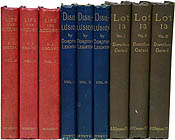The Three-Volume Format
![]()
From the early 1800s until the 1890s, most full-length
new fiction was published in three volumes (often called a "three-decker"
or "triple-decker"). The market for the three-volume format
was driven in large part by the giant subscription circulating libraries,
such as Mudie’s and W.H. Smith’s, which operated much like our
video rental stores today.
Novels were expensive to buy, and at 31 shillings and sixpence for three volumes (about £1.60), beyond the reach of all but the wealthiest readers. The circulating libraries favored the three-volume format–and pressured publishers to adhere to it–because the high price of triple-deckers encouraged readers to borrow rather than buy. And if a novel could be split into three volumes, three times as much money could be made renting it out on a per-volume basis.

Copyright
© 2002 Division of Rare & Manuscript
Collections
2B Carl A. Kroch Library, Cornell University, Ithaca, NY, 14853
Phone Number: (607) 255-3530. Fax Number: (607) 255-9524
For
reference questions, send mail to:
rareref@cornell.edu
If you have questions or comments about the site, send mail to: webmaster.
